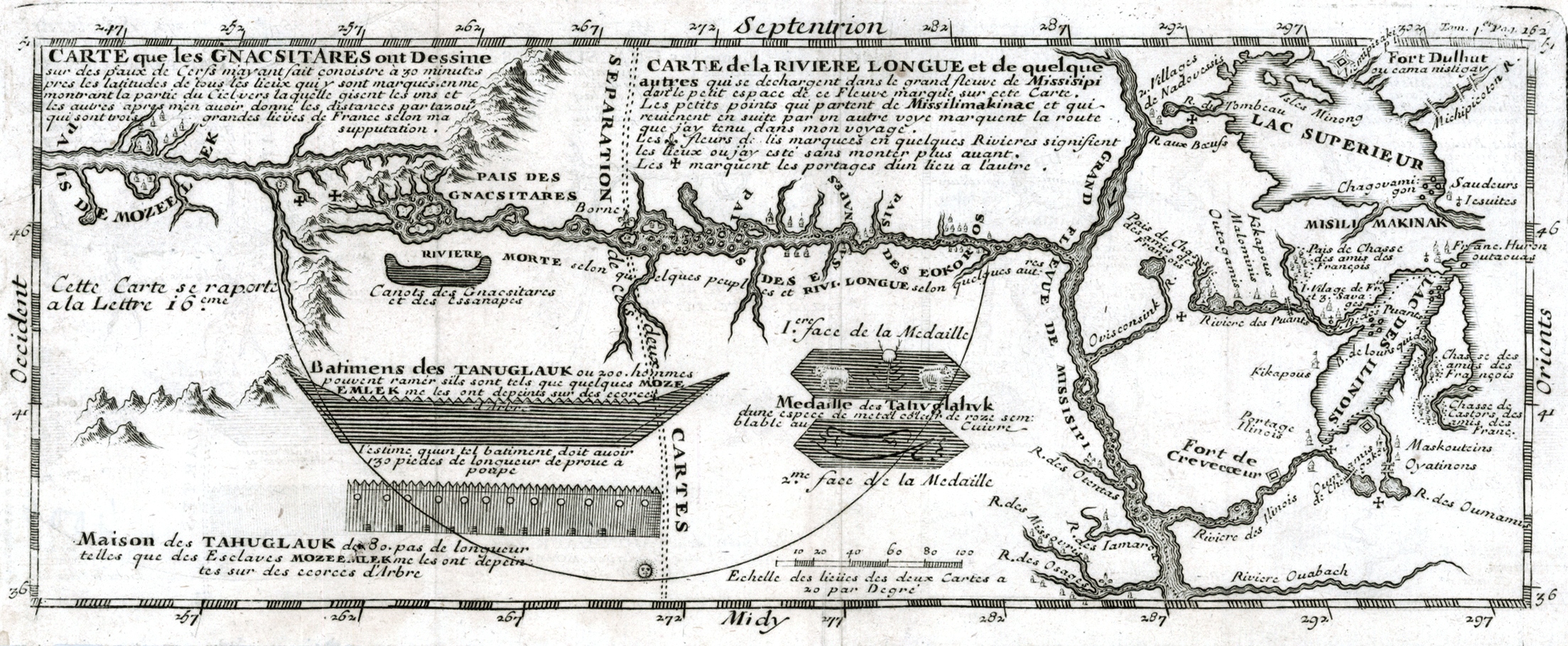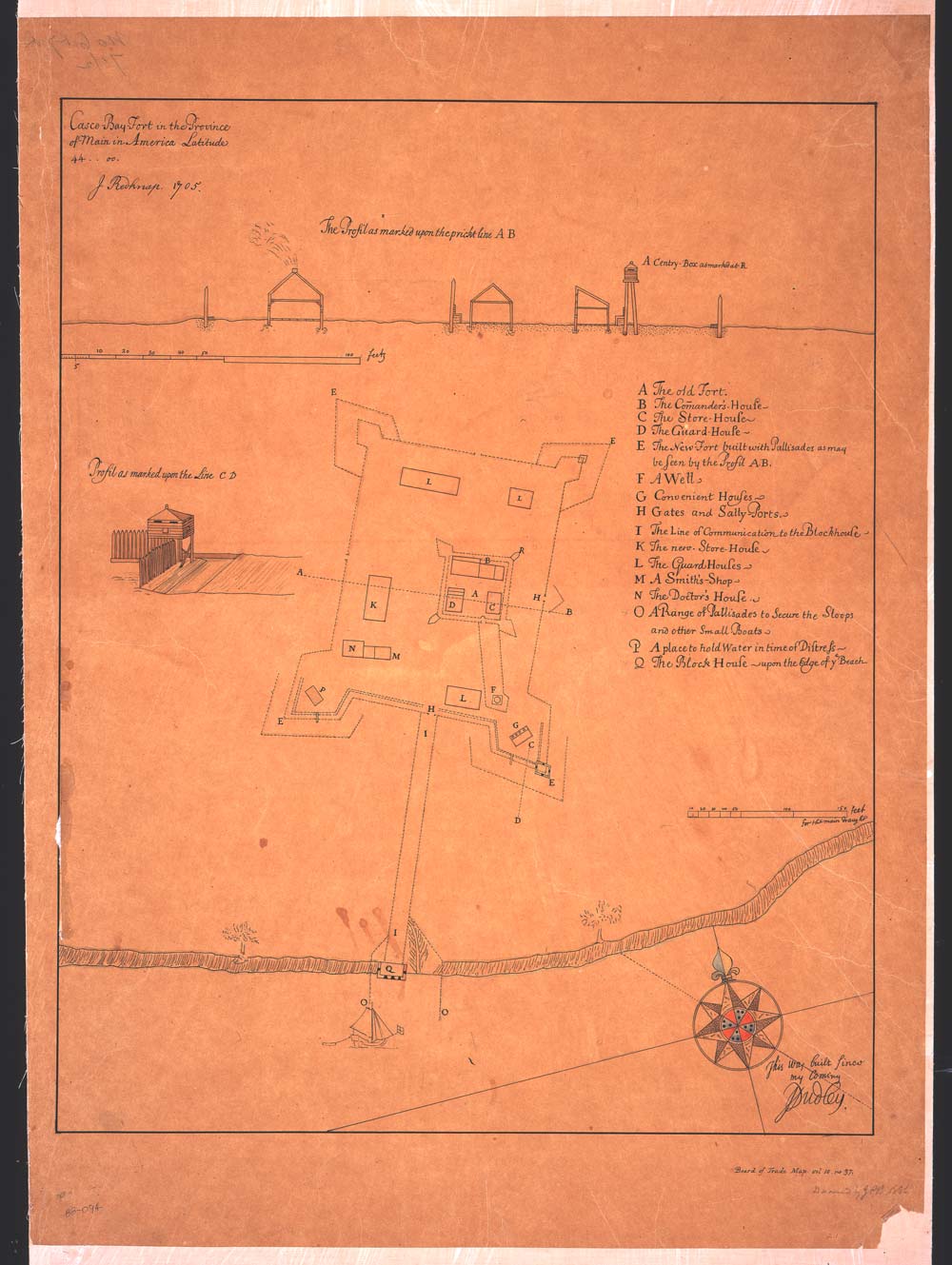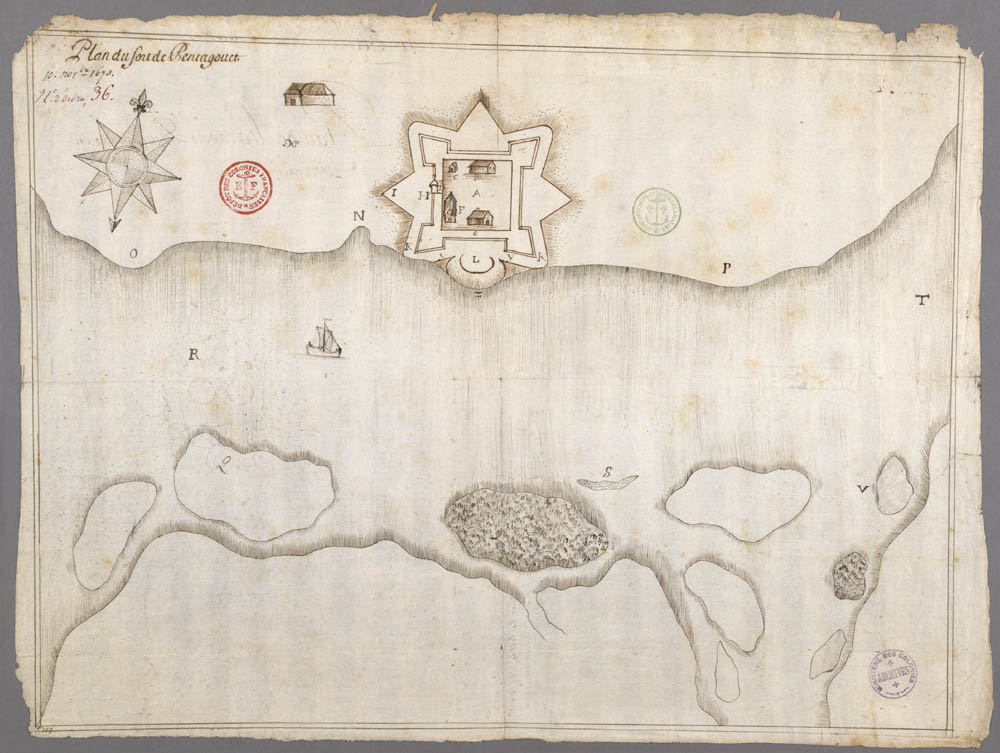|
Jean-Vincent D'Abbadie De Saint-Castin
Jean-Vincent d'Abbadie, Baron de Saint-Castin (; 1652–1707) was a French military officer serving in Acadia and an Abenaki chief. He is the father of two prominent sons who were also military leaders in Acadia: Bernard-Anselme and Joseph. He is the namesake of Castine, Maine. He died at Pau, France, in 1707. Early life Saint-Castin was born at Escout, Béarn, France, to Jean-Jacques d'Abbadie and Isabeau de Béarn-Bonasse, the youngest of three sons. Little is known of his early years other than he lost his mother in infancy and his father before his teens. He left for Canada at the age of thirteen as an ensign in the army, as was suitable for the youngest son of a noble. He was likely part of Alexandre de Prouville's campaign against the Iroquois in 1666 although his name does not appear in surviving records until 1670 when he was part of the repossession of Acadia by the French. In the Penobscot River area he gained his knowledge of the Penobscot and was eventually adopt ... [...More Info...] [...Related Items...] OR: [Wikipedia] [Google] [Baidu] |
Escout
Escout (; ) is a Communes of France, commune in the Pyrénées-Atlantiques Departments of France, department in south-western France. See also *Communes of the Pyrénées-Atlantiques department References Communes of Pyrénées-Atlantiques {{OloronSainteMarie-geo-stub ... [...More Info...] [...Related Items...] OR: [Wikipedia] [Google] [Baidu] |
Iroquois
The Iroquois ( ), also known as the Five Nations, and later as the Six Nations from 1722 onwards; alternatively referred to by the Endonym and exonym, endonym Haudenosaunee ( ; ) are an Iroquoian languages, Iroquoian-speaking Confederation#Indigenous confederations in North America, confederacy of Native Americans in the United States, Native Americans and First Nations in Canada, First Nations peoples in northeast North America. They were known by the French during the Colonial history of the United States, colonial years as the Iroquois League, and later as the Iroquois Confederacy, while the English simply called them the "Five Nations". Their country has been called wikt:Iroquoia, Iroquoia and Haudenosauneega in English, and '':fr:Iroquoisie, Iroquoisie'' in French. The peoples of the Iroquois included (from east to west) the Mohawk people, Mohawk, Oneida people, Oneida, Onondaga people, Onondaga, Cayuga people, Cayuga, and Seneca people, Seneca. After 1722, the Iroquoian-sp ... [...More Info...] [...Related Items...] OR: [Wikipedia] [Google] [Baidu] |
Emmanuel Le Borgne
Emmanuel Le Borgne de Belle-Isle (1610 – 5 August 1675) was the governor of Acadia in 1657–67 and was the claimant to the estate of Charles de Menou d'Aulnay who had governed Acadia until his death. Le Borgne was a highly successful merchant in France and had financed d’Aulnay in his Acadian trade. When d’Aulnay died by drowning, Le Borgne laid formal claim to the estate. He then sent an expedition to Acadia the next year to attempt a monopoly of the trade and secure the money owed to him. His youngest son, Alexandre Le Borgne de Belle-Isle, acted as governor temporarily, ahead of his father's arrival to Acadia. His competition was Charles de Saint-Étienne de la Tour at Saint John (whose daughter, Marie, was, in 1668, wed to his son, Alexandre) and another former governor of Acadia, Nicolas Denys, at Cape Breton. In 1653, along with raiding Pentagouet (Castine, Maine), LaHave, Nova Scotia, and Nipisguit (Bathurst, New Brunswick Bathurst () is a city in norther ... [...More Info...] [...Related Items...] OR: [Wikipedia] [Google] [Baidu] |
Alexandre Le Borgne De Belle-Isle
Alexandre le Borgne de Belle-Isle (1640 – c. 1693), the son of Emmanuel Le Borgne, was a temporary governor of Acadia and seigneur of Port Royal. Around 1675, he married Marie de Saint-Étienne de La Tour, daughter of Charles de Saint-Étienne de La Tour and Jeanne Motin de Reux, widow of Acadian Governor, Charles de Menou d'Aulnay Charles de Menou d'Aulnay (''de Charnisay'') (–1650) was a French pioneer of European settlement in North America and Governor of Acadia (1635–1650). D'Aulnay was a member of the French nobility who was at various times a sea captain, a lie .... In 1690, he was an interpreter in the negotiation of the surrender of Port Royal to William Phips. Le Borgne inherited his rights in Acadia from his father, who, in turn, claimed the governorship and seigneurial rights in Acadia on the death of d'Aulnay in 1650, due to large debts owed. Although the governorship passed to Hector d'Andigné de Grandfontaine in 1670, Le Borgne exercised seigneurial righ ... [...More Info...] [...Related Items...] OR: [Wikipedia] [Google] [Baidu] |
Castine Hoard
The Castine Hoard (also known as ''The Castine Deposit'') is the name given to a treasure trove of around 500–2,000 North American colonial coins that were found in Castine, Maine, United States. The coins were from various countries, and were buried sometime in the late 1600s. In the early 1840s the coins were discovered on a farm owned by the Grindle family. Origin The coins were thought to have been a secret stash belonging to Baron Jean-Vincent d'Abbadie de Saint-Castin. Castin moved from France to the new world, becoming a battalion leader and later a baron following the death of his father. Jean eventually fell in love with the trading post of Pentagoet, and moved there once his army duties had been complete. While in Pentagoet he became more than friendly with the Indians, eventually becoming a local chief. Jean later married the daughter of another chief, and they had a daughter. In 1704, British forces led by Major Church stormed and captured the village of Pentagoe ... [...More Info...] [...Related Items...] OR: [Wikipedia] [Google] [Baidu] |
John Alden (sailor)
Capt. John Alden Jr. (ca. 1626 or 1627 – homepages.rootsweb.com; accessed January 20, 2019.His gravestone, which used the and the Annunciation Style of enumerating years with , recorded his death as having occurred on March 14, 1701/2: "Here lyeth ye body of John Alden Senior aged 75 years deceased March ye 14 1701/2". See also |
Louis-Armand De Lom D'Arce De Lahontan, Baron De Lahontan
Louis Armand, Baron de Lahontan (9 June 1666 – before 1716) was a French aristocrat, writer, and explorer who served in the French military in Canada, where he traveled extensively in the Wisconsin and Minnesota region and the upper Mississippi Valley. Upon his return to Europe he wrote an enormously popular New Voyages to North America, travelogue. In it he recounted his voyage up the "Long River," now thought to be the Missouri. He wrote at length and in very positive terms about Native American culture, portraying Indian people as free, rational, and generally admirable. Early life Louis Armand was born into the aristocracy and inherited the title Baron Lahontan upon his father's death in 1674. De Lahontan joined the French Marines in Canada, 1683-1715, troupes de la marine and was sent to New France in 1683 at age 17 along with two other officers and three companies of troops.Lanctôt, Gustave. The Oakes Collection. Ottawa: J.O. Patenaude, 1940. 11. After arriving at Que ... [...More Info...] [...Related Items...] OR: [Wikipedia] [Google] [Baidu] |
Madokawando
Madockawando (born in Maine c. 1630; died 1698) was a sachem of the Penobscot, an adopted son of ''Assaminasqua,'' whom he succeeded. He led the Penobscot on the side of the French against the English during King William's War. Biography The Penobscot lands, lying east of Penobscot River, were a part of the French colony of Acadia. The English returned this to France in the 1667 Treaty of Breda, though the English claimed that the territory between the Penobscot and the St. Croix Rivers was included in the Duke of York's patent. The Native Americans in the region were brought under French influence by Jean-Vincent d'Abbadie de Saint-Castin, known as Castin in the ''New England Chronicles,'' who was a trader who did much to gain influence with the Abenaki, Penobscot, and other local tribes. He settled among them, and married a daughter of ''Madockawando,'' a Penobscot chief. When King Philip's confederacy entered into a state of war with the Plymouth Colony, the eastern Penobs ... [...More Info...] [...Related Items...] OR: [Wikipedia] [Google] [Baidu] |
Falmouth, Maine
Falmouth ( ) is a town in Cumberland County, Maine, United States. The population was 12,444 at the 2020 census. It is part of the Portland-South Portland-Biddeford metropolitan area. A northern suburb of Portland, Falmouth borders Casco Bay and offers one of the largest anchorages in Maine. The town is home to three private golf clubs and the Portland Yacht Club. History Native Americans Native Americans followed receding glaciers into Maine around 11,000 BCE. At the time of European contact in the sixteenth century, people speaking a western dialect of the Wabanaki language inhabited present-day Falmouth. Captain John Smith observed a semi-autonomous band known as the Aucocisco living in Casco Bay. English explorer Christopher Levett met with the Aucocisco Sagamore Skittery Gusset at his summer village at the Presumpscot Falls in 1623. A combination of warfare and disease decimated Native peoples in the years before English colonization, creating a shatter zone ... [...More Info...] [...Related Items...] OR: [Wikipedia] [Google] [Baidu] |
Benjamin Church (ranger)
Colonel Benjamin Church ( – January 17, 1718) was a New England military officer and politician who is best known for his role in innovative military tactics notably developing unconventional warfare. He is also known for commanding the first ranger units in North America. Born in the Plymouth Colony, Church was commissioned by Governor Josiah Winslow to establish a company of Rangers called after the outbreak of King Philip's War. Church participated in numerous conflicts which involved the New England Colonies. The force of New Englanders he led tracked down and killed Wampanoag sachem Metacomet, a major factor in ending the conflict.John Grenier. ''The First Way of War: American War Making on the Frontier.'' Cambridge University Press. 2005. p. 35 During the French and Indian Wars, Church participated in asymmetric warfare against the French and their indigenous allies. He led troops to raid the French colony of Acadia during King William's War and Queen Anne's War. St ... [...More Info...] [...Related Items...] OR: [Wikipedia] [Google] [Baidu] |
King Philips War
King Philip's War (sometimes called the First Indian War, Metacom's War, Metacomet's War, Pometacomet's Rebellion, or Metacom's Rebellion) was an armed conflict in 1675–1678 between a group of indigenous peoples of the Northeastern Woodlands against the English New England Colonies and their indigenous allies. The war is named for Metacom (alternatively Metacomet), the Pokanoket chief and sachem of the Wampanoag who had adopted the English name Philip because of the friendly relations between his father Massasoit and the Plymouth Colony. The war continued in the most northern reaches of New England until the signing of the Treaty of Casco Bay on April 12, 1678. Massasoit had maintained a long-standing agreement with the colonists and Metacom (), his younger son, became the tribal chief in 1662 after his father's death. Metacom, however, forsook his father's alliance between the Wampanoags and the colonists after repeated violations by the latter. The colonists insisted that ... [...More Info...] [...Related Items...] OR: [Wikipedia] [Google] [Baidu] |
Fort Pentagouet
Fort Pentagouët (Fort Pentagoet, Fort Castine, Fort Penobscot, Fort Saint-Pierre) was a French fort established in present-day Castine, Maine, which was the capital of Acadia (1670–1674). It is the oldest permanent settlement in New England. Its commanding position at the mouth of the Penobscot River estuary, a lucrative source of furs and timber, as well as a major transportation route into the interior, made the peninsula of particular interest to European powers in the 17th century. Majabagaduce (as the Abenaki name would be corrupted) changed hands numerous times with shifting imperial politics. At one time or another, it was occupied by the French, Dutch and England's Plymouth Colony. La Tour Castine was founded in the winter of 1613, when Claude de Saint-Étienne de la Tour established a small trading post to conduct business with the Tarrantine Indians. After the trading post was established at Castine, a raid by English captain Samuel Argall at Mount Desert Is ... [...More Info...] [...Related Items...] OR: [Wikipedia] [Google] [Baidu] |






